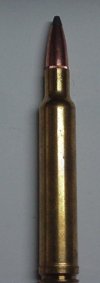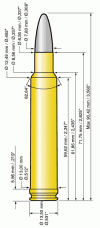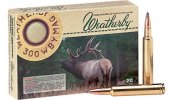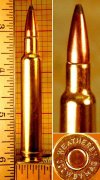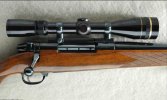monish
AH elite
.300 Weatherby Magnum
Roy Weatherby already had experience with other custom cartridges such as his own .270 Weatherby Magnum when he created the .300 Wby. Like most of his other magnum cartridges, this is based on a blown-out .300 H&H Magnum case, using the signature Weatherby double-radius shoulder. In 1944, Roy Weatherby designed and introduced the 300 Weatherby Magnum, which, until the 1962 introduction of the 340 Weatherby Magnum, was the last member of his cartridge line to be based upon the original H&H belted case. The 300 Weatherby uses the full-length case and will only work properly in long-action rifles. Until quite recently, it featured the largest commercial 30-caliber case and, given at least a 26-inch barrel, performance is quite impressive. Skilled hunters have successfully used this chambering on practically every species, worldwide, and it is a favorite among an entire class of famous hunters who took to the game fields shortly after WWII, when Weatherby could finally offer commercially chambered rifles and superior factory ammunition, as loaded by Norma.
Performance
Weatherby claims that this is the most powerful .30 caliber magnum rifle commercially available, but the recently introduced .300 RUM is now more powerful. Of course there are quite a few very large .30 caliber wildcats around, not to mention Weatherby's own .30-378 Weatherby Magnum.
One must note however when comparing the .300 RUM and the .300 Weatherby Magnum the difference in factory loadings. Performance data is often listed on the side of the ammunition box for those who wish to do an in-store comparison. On average the Weatherby cartridge is listed with higher performance. This is because from the factory Weatherby loads its rounds with a greater powder charge than does Remington. This is because Remington generally sells rounds below the cartridges maximum performance envelope so that its recoil will be more forgiving to shooters. In order to take advantage of the greater case capacity of the non-belted Remington round one must handload it to a greater powder charge. The 300 Weatherby generally outperforms any short magnum 30-caliber by a significant margin. Therefore, for the practiced and skilled marksman, it will add, perhaps, 50 to 100 yards of useful range in any given application. Moreover, perhaps surprisingly, partly due to superior quality of Norma cases, the 300 Weatherby case has been used as the basis for an entire genre of full-length wildcats, for both hunting and long-range target shooting. While newer, generally shorter, developments threaten the continued popularity of this number, it is still a fine choice for the hunter who can handle the recoil, muzzle blast and long bolt stroke required in a gun so chambered.
The .300 Wby is in common use by big game hunters all over the world.
Monish
Roy Weatherby already had experience with other custom cartridges such as his own .270 Weatherby Magnum when he created the .300 Wby. Like most of his other magnum cartridges, this is based on a blown-out .300 H&H Magnum case, using the signature Weatherby double-radius shoulder. In 1944, Roy Weatherby designed and introduced the 300 Weatherby Magnum, which, until the 1962 introduction of the 340 Weatherby Magnum, was the last member of his cartridge line to be based upon the original H&H belted case. The 300 Weatherby uses the full-length case and will only work properly in long-action rifles. Until quite recently, it featured the largest commercial 30-caliber case and, given at least a 26-inch barrel, performance is quite impressive. Skilled hunters have successfully used this chambering on practically every species, worldwide, and it is a favorite among an entire class of famous hunters who took to the game fields shortly after WWII, when Weatherby could finally offer commercially chambered rifles and superior factory ammunition, as loaded by Norma.
Performance
Weatherby claims that this is the most powerful .30 caliber magnum rifle commercially available, but the recently introduced .300 RUM is now more powerful. Of course there are quite a few very large .30 caliber wildcats around, not to mention Weatherby's own .30-378 Weatherby Magnum.
One must note however when comparing the .300 RUM and the .300 Weatherby Magnum the difference in factory loadings. Performance data is often listed on the side of the ammunition box for those who wish to do an in-store comparison. On average the Weatherby cartridge is listed with higher performance. This is because from the factory Weatherby loads its rounds with a greater powder charge than does Remington. This is because Remington generally sells rounds below the cartridges maximum performance envelope so that its recoil will be more forgiving to shooters. In order to take advantage of the greater case capacity of the non-belted Remington round one must handload it to a greater powder charge. The 300 Weatherby generally outperforms any short magnum 30-caliber by a significant margin. Therefore, for the practiced and skilled marksman, it will add, perhaps, 50 to 100 yards of useful range in any given application. Moreover, perhaps surprisingly, partly due to superior quality of Norma cases, the 300 Weatherby case has been used as the basis for an entire genre of full-length wildcats, for both hunting and long-range target shooting. While newer, generally shorter, developments threaten the continued popularity of this number, it is still a fine choice for the hunter who can handle the recoil, muzzle blast and long bolt stroke required in a gun so chambered.
The .300 Wby is in common use by big game hunters all over the world.
Monish
